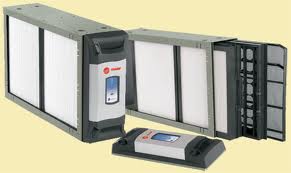More and more we are hearing about the importance of clean air in our homes. Part of the work of the Environmental Protection Agency (EPA) is to promote and insure clean air in our homes, cities, and states. It is a well known fact that often there are more pollutants IN our homes, than those outside our homes. It is also well known that millions of people suffer daily with asthma, pulmonary lung disease, allergies, hay fever, and reactions to mold, mildew and dust. What is a person to do to have clean air in their homes?

We can't live in a bubble, so the best thing we can do is to first, eliminate as many of the products from our homes that cause irritation to our lungs. Things like perfumes, chemical cleaning compounds, pesticides, and the like. Even carpet can be a host home for many airborne allergens and dust. Personally, I like carpet. Living in the Boise, Treasure Valley of Idaho, carpet feels really nice on a cold winter morning. So for me, getting rid of my carpet is not going to work. In the summer we live outdoors as much as we do indoors so the doors are being opened and closed and that allows more pollutants into our home.
What I can suggest, and what I am using, is a 'whole home' electronic air cleaner.
These units install right in the return air duct of your central heating and cooling system. There are some units on the market like, Trane CleanEffects, that will purify the air down to .01 microns. This will scrub the air of 99.98% of mold, mildew, influenza, allergens and the like.
A good air purifier should be at least a three stage system, including a
pre-filter that will pick up most dust, lint, pet hair, & etc. The second stage is usually the
electronic part in which the atoms are changed to attract pollen and other allergens. The third stage generally consists of specially manufactured
filter material that filter out the microscopic bacteria and dangerous influenza. At the same time as these filters are working, your system delivers clean, purified air to your home. A quality system like Trane CleanEffects does not require purchasing new filters for up to ten years. The filters can be vacuumed, washed, and replaced.
Some folks like to use small portable air cleaners but, frankly, these do not perform as well as a whole house unit in delivering clean air. Plus, they are really only good for a single room or area. Others use what are called "HEPA" filters and 4" pleated filters in their furnace, and these are good, but again. they do not capture 99.98% of pollutants and they do not capture influenza virus. So, to breathe easy at home. To save money by not going to the doctor so much. To ease up on your purchase of over-the-counter allergy medication and perscription medication. Invest that saved money in a whole-home air cleaning system. For more information, check my other blogs at
hvaccomfortguyjerry@blogspot.com or go to our website at
www.greensheating.com.

































